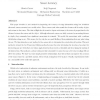Free Online Productivity Tools
i2Speak
i2Symbol
i2OCR
iTex2Img
iWeb2Print
iWeb2Shot
i2Type
iPdf2Split
iPdf2Merge
i2Bopomofo
i2Arabic
i2Style
i2Image
i2PDF
iLatex2Rtf
Sci2ools
ICRA
1999
IEEE
1999
IEEE
The Arc-Transversal Median Algorithm: An Approach to Increasing Ultrasonic Sensor Accuracy
This paper describes a new method for improving the accuracy of range information using low resolution ultrasonic sensors mounted on a mobile robot. These sensors emit ultra-sound that bounces o of nearby objects and returns to the sensor. The time-of- ight for the sound to depart and return to the sensor is proportional to the distance between the sensor and the object. Although ultrasonic sensors are fairly accurate in measuring distance in depth, they commonly have signi cant uncertainty in azimuth. We model this uncertainty with a uniform distribution along an arc. This means, for the echo has an equal likelihood from originating from any point along the arc. We then introduce a new method to fuse sonar data to determine the actual obstacle location. This new method is termed the Arc Transversal Median method because the robot determines the location of an object by intersecting one arc with other arcs whose angle-of-intersection exceeds a threshold and then taking the median of t...
| Added | 03 Aug 2010 |
| Updated | 03 Aug 2010 |
| Type | Conference |
| Year | 1999 |
| Where | ICRA |
| Authors | Keiji Nagatani, Howie Choset, Nicole A. Lazar |
Comments (0)

